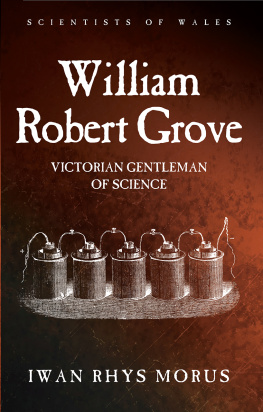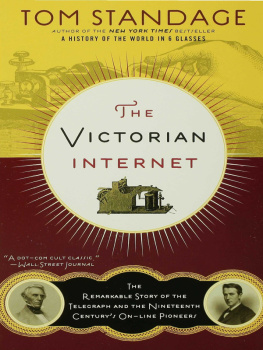CONTENTS
SCIENTISTS OF WALES
William
Robert Grove
SCIENTISTS OF WALES
Series Editor
Professor Gareth Ffowc Roberts
Bangor University
Editorial Panel
John V. Tucker
Swansea University
Iwan Rhys Morus
Aberystwyth University
SCIENTISTS OF WALES
William
Robert Grove
VICTORIAN GENTLEMAN
OF SCIENCE
IWAN RHYS MORUS
UNIVERSITY OF WALES PRESS
2017
Iwan Rhys Morus, 2017
All rights reserved. No part of this book may be reproduced in any material form (including photocopying or storing it in any medium by electronic means and whether or not transiently or incidentally to some other use of this publication) without the written permission of the copyright owner except in accordance with the provisions of the Copyright, Designs and Patents Act 1988. Applications for the copyright owners written permission to reproduce any part of this publication should be addressed to the University of Wales Press, 10 Columbus Walk, Brigantine Place, Cardiff CF10 4UP.
www.uwp.co.uk
British Library Cataloguing-in-Publication Data
A catalogue record for this book is available from the British Library.
ISBN 978-1-78683-020-3 hardback
978-1-78683-004-3 paperback
eISBN 978-1-78683-006-7
The right of Iwan Rhys Morus to be identified as author of this work has been asserted in accordance with sections 77, 78 and 79 of the Copyright, Designs and Patents Act 1988.
Cover image: The Grove cell battery, first developed 18389 (image source Alamy).


i fy nhad
CONTENTS
W ales has a long and important history of contributions to scientific and technological discovery and innovation stretching from the Middle Ages to the present day. From medieval scholars to contemporary scientists and engineers, Welsh individuals have been at the forefront of efforts to understand and control the world around us. For much of Welsh history, science has played a key role in Welsh culture: bards drew on scientific ideas in their poetry; renaissance gentlemen devoted themselves to natural history; the leaders of early Welsh Methodism filled their hymns with scientific references. During the nineteenth century, scientific societies flourished and Wales was transformed by engineering and technology. In the twentieth century the work of Welsh scientists continued to influence developments in their fields.
Much of this exciting and vibrant Welsh scientific history has now disappeared from historical memory. The aim of the Scientists of Wales series is to resurrect the role of science and technology in Welsh history. Its volumes trace the careers and achievements of Welsh investigators, setting their work within their cultural contexts. They demonstrate how scientists and engineers have contributed to the making of modern Wales as well as showing the ways in which Wales has played a crucial role in the emergence of modern science and engineering.
RHAGAIR GOLYGYDD Y GYFRES
O r Oesoedd Canol hyd heddiw, mae gan Gymru hanes hir a phwysig o gyfrannu at ddarganfyddiadau a menter gwyddonol a thechnolegol. Or ysgolheigion cynharaf i wyddonwyr a pheirianwyr cyfoes, mae Cymry wedi bod yn flaenllaw yn yr ymdrech i ddeall a rheolir byd on cwmpas. Mae gwyddoniaeth wedi chwarae rl allweddol o fewn diwylliant Cymreig am ran helaeth o hanes Cymru: arferair beirdd llys dynnu ar syniadau gwyddonol yn eu barddoniaeth; roedd gan wr y Dadeni ddiddordeb brwd yn y gwyddorau naturiol; ac roedd emynau arweinwyr cynnar Methodistiaeth Gymreig yn llawn cyfeiriadau gwyddonol. Blodeuodd cymdeithasau gwyddonol yn ystod y bedwaredd ganrif ar bymtheg, a thrawsffurfiwyd Cymru gan beirianneg a thechnoleg. Ac, yn ogystal, bu gwyddonwyr Cymreig yn ddylanwadol mewn sawl maes gwyddonol a thechnolegol yn yr ugeinfed ganrif.
Mae llawer or hanes gwyddonol Cymreig cyffrous yma wedi hen ddiflannu. Amcan cyfres Gwyddonwyr Cymru yw i danlinellu cyfraniad gwyddoniaeth a thechnoleg yn hanes Cymru, i chyfrolaun olrhain gyrfaoedd a champau gwyddonwyr Cymreig gan osod eu gwaith yn ei gyd-destun diwylliannol. Trwy ddangos sut y cyfrannodd gwyddonwyr a pheirianwyr at greur Gymru fodern, dadlennir hefyd sut y mae Cymru wedi chwarae rhan hanfodol yn natblygiad gwyddoniaeth a pheirianneg fodern.
I t is quite easy to imagine an alternative steampunk universe in which William Robert Grove is celebrated as the inaugurator of a second Victorian industrial revolution. In this parallel world, his invention of the gas battery in 1841 revolutionised transportation, and killed off the steam locomotive before it had a chance to monopolise the railways. Banks of gas batteries, fuelled by cheap hydrogen produced from coal, powered horseless carriages on the roads as well as the railways, making possible fast and reliable travel beyond the confines of the rail network. The cheap power generated from coal-produced hydrogen quickly made electricity a serious competitor for steam in a variety of industries too. Crucially, the gas battery brought electricity into the Victorian home as well. By the 1860s, large gasometers filled with hydrogen were a common sight in Victorian towns and cities. Networks of pipes carried the gas to middle-class homes to provide fuel for gas batteries that powered not only electric lights but the whole range of electrical gadgetry that packed Victorian houses. Appliances for washing dishes, doing the laundry, cleaning carpets and curtains, even cooking, were all powered using Groves ubiquitous gas batteries. They operated the magic lanterns that provided middle-class Victorians with their evenings domestic entertainment.
None of this happened, of course. But let us imagine another alternative history instead, observed this time from the perspective of the twenty-second century. In this history, Grove is the hero again. During the early decades of the twenty-first century nearly two centuries after it was invented Groves gas battery, now called the fuel cell, transformed transportation. It provided a solution to increasingly urgent problems of climate change and the pollution produced by hydrocarbon-based fossil fuels. Cars and lorries powered by fuel cells, running on hydrogen gas generated by electrolysis using solar power, inaugurated a revolution in low-emission travel. The only by-product of combining hydrogen and oxygen to make electricity is water, after all. The fuel cell generated none of the greenhouse gases that bedevilled the traditional petrol- or diesel-powered internal combustion engine. It helped too that it ran on fuel that could be found anywhere there was water, rather than one derived from increasingly scarce and expensive to acquire oil. Groves gas battery therefore played a key role in the battle to reduce environmentally harmful emissions and contain climate change that dominated the second half of the twenty-first century and Grove himself became an icon for the drive towards clean energy.
This has not happened yet, of course. But there are signs already that this really is one plausible route that the history of twenty-first-century energy use might follow. In the years immediately following his invention, Groves gas battery received very little attention other than as a philosophical curiosity. It certainly did not strike anyone at the time Grove included as a potential source of power on an industrial scale, even though many electricians at the time already regarded electric power as a viable competitor for steam. Grove did suggest in 1854,














